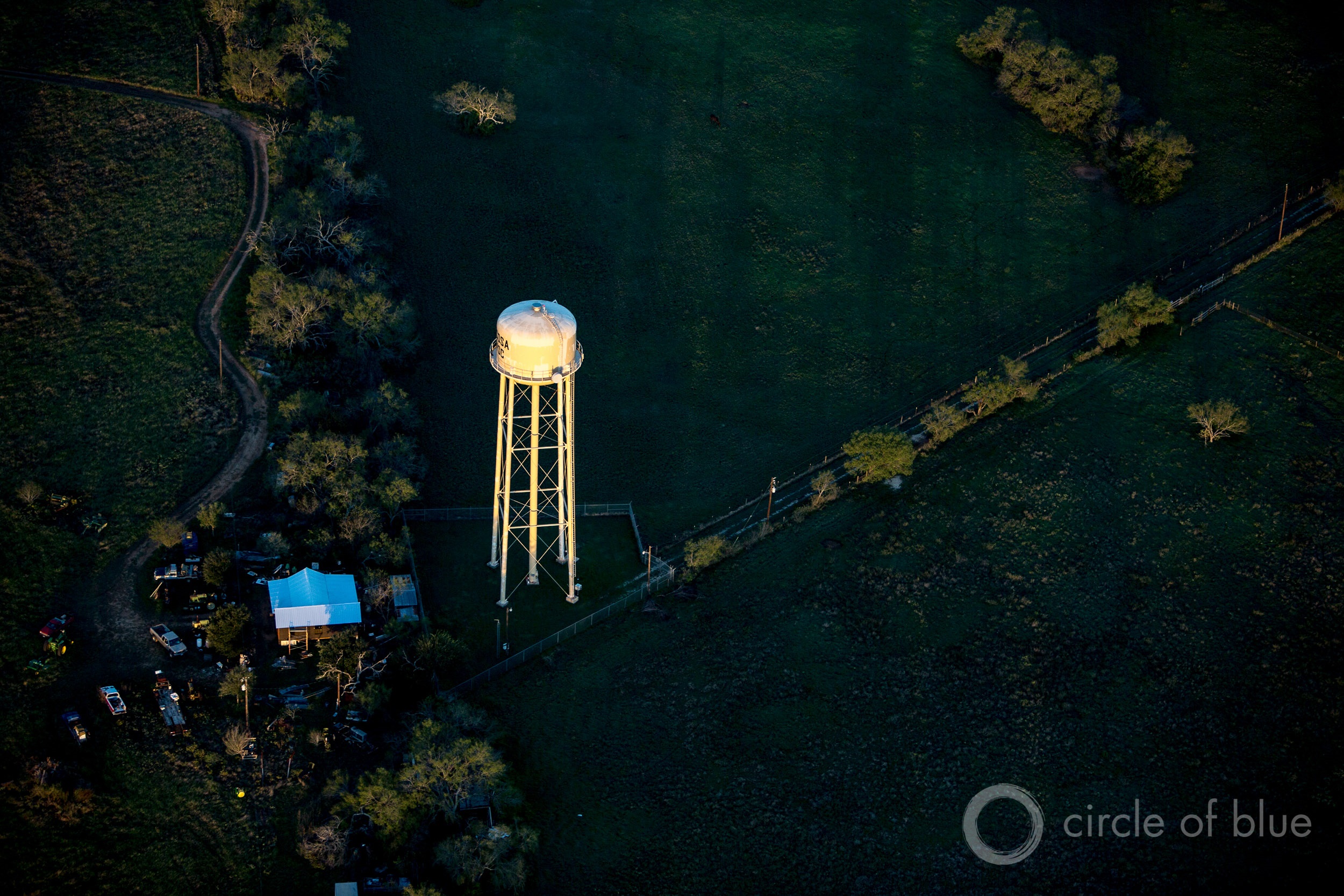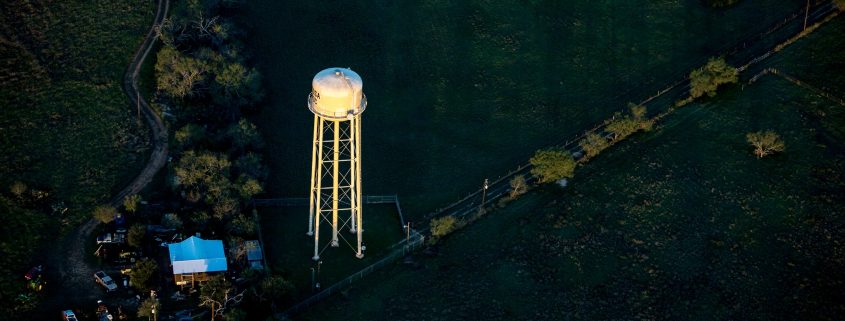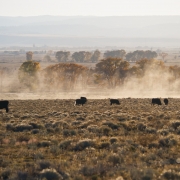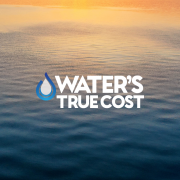Water Utilities Want a Bailout. Will Congress Listen?
The financial fallout to a critical sector and the people it serves is expected to be severe.

A water tower rises above a town near San Antonio, Texas. Photo © J. Carl Ganter / Circle of Blue
By Brett Walton, Circle of Blue
Water and wastewater utilities and their customers were ignored in Congress’s three coronavirus relief bills.
The first two bills provided support to health and medical services through the early stages of the Covid-19 crisis. The CARES Act, the monumental third piece of legislation that was signed into law on March 27, unloaded more than $2.2 trillion in federal aid on individuals, businesses, and large cities — but still none for the utilities that deliver drinking water and purify sewage. (A fourth action last week replenished a worker assistance fund.)
The industry and its advocates view that as a grievous oversight and have regrouped. They are backing a two-phase plan to extend a lifeline to water utilities and customers who cannot pay their bills during an economic crisis, and to invest for the future.
Step one in the plan is the provision of emergency assistance to both groups. There is still a debate about the size of an aid package for utilities and the most efficient and effective way of helping customers. But $1.5 billion in customer assistance is a common starting point in discussions.
The second step is a longer-term investment in the nation’s water systems. Infrastructure debates have moved to the back burner in recent weeks as the need for more financial assistance to address the immediate crisis became apparent. Republicans, meanwhile, have started to become leery of additional spending to prop up state and local budgets during the crisis. Nonetheless, House Democrats are proposing roughly $50 billion to bolster water and sewer infrastructure and reduce pollution.
Rep. Peter DeFazio, the Oregon Democrat who chairs the House Transportation and Infrastructure Committee, summed up the current state of play. Though neglected so far, emergency aid for utilities and customers is a Democratic priority for the next round of coronavirus relief, he said.
“We haven’t given up,” DeFazio said. “We’re working on CARES Two, and we hope to get something in there.” His remarks were recorded and aired during an April 29 webinar for Water Week, the water industry’s annual D.C. lobbying event, which took place remotely this year.
“I know many utilities right now are distressed,” DeFazio added. He mentioned a utility in his district whose revenue has fallen by 60 percent because two of its large industrial customers shut down their operations during the pandemic. “They’re seeing a major reduction in revenues, and we’re hopeful we can do something directly to utilities also in future legislation.”
Financial Uncertainty
Apprehension about the coming months abounds. An industry-commissioned report estimates that U.S. drinking water utilities will lose $13.9 billion in revenue due to fallout from the coronavirus pandemic. Such a hit could result in delayed investment, pipes that are not maintained, and worsening affordability problems down the road if utilities raise rates to replenish their reserves. City governments are already furloughing staff and freezing new hires as they anticipate double-digit declines in tax revenues.
The accounting in the report includes revenue losses from declining commercial use, nonpayment of bills, fewer connection fees charged to new development, and a slight rise in operating expenses due to pandemic precautions. The tally also includes anticipated revenue increases from rising residential use as a result of stay-home orders. The effect on any individual utility — there are roughly 50,000 drinking water providers in the United States — depends on its mix of industrial, commercial, and residential customers.
Pittsburgh Water and Sewer Authority, for example, says that it has seen about a 12 percent decline in water demand with the widespread closure of restaurants and colleges in the city. The utility is still assessing the effect on revenue, according to Rebecca Zito, a spokesperson.
The report estimates an additional revenue loss of $1.6 billion if utilities delay planned rate increases. The report was prepared by the consulting firm Raftelis and commissioned by the American Water Works Association and the Association of Metropolitan Water Agencies.
“Revenue is definitely going to be a problem,” Eric Fuchs of the Missouri Rural Water Association told Circle of Blue.
The National Rural Water Association estimates that its membership — utilities that serve fewer than 10,000 customers — could lose nearly $1 billion in the crisis.
That cash is direly needed, said Fuchs, who is leading the emergency response for rural water utilities in Missouri. There’s isn’t a lot of room for financial error, he said: “Some utilities run pretty close to the margin already.”
In these cases, aid is necessary so that utilities “don’t fail as organizations in this crisis for want of revenue,” said Manny Teodoro, an associate professor at Texas A&M University who studies water policy.
The wastewater industry, meanwhile, compiled its own figures. If revenue declines by 20 percent across the board, the nation’s roughly 16,000 sewage-treating utilities stand to lose some $12.5 billion. That coarse estimate does not include losses from customers who do not pay their bills.
“If anything we believe that number is conservative,” Kristina Surfus of the National Association of Clean Water Agencies, the industry trade group that came up with the estimate, told Circle of Blue. Surfus, the managing director of government affairs, has heard from member utilities that expect revenue losses of up to 40 percent.
Fuchs said that more clarity on the financial implications should come in May, once utilities have a billing cycle that reflects a full month of lockdown.
Hitting Home
Utility customers are also feeling the pinch. As job losses soared in April beyond any historical precedent, governors and utilities sought to extend relief for those suddenly without a paycheck and for those already financially insecure. Many utilities said they would stop shutting off water for nonpayment. A few, like Gov. Gretchen Whitmer of Michigan, ordered utilities to reconnect all homes where water had been disconnected.
With these households in mind, a rising number of representatives in Congress have rallied around an old idea: a national customer aid program for water bills. Such a program exists for energy bills.
First introduced in 2016, the water aid program has the support of dozens of House Democrats. Sixty-eight of them endorsed a bill from Reps. Debbie Dingell and Rashida Tlaib, both Michigan Democrats, that would offer states and tribes $1.5 billion to aid low-income households with their water bills.
The question, though, is how to get aid to households. The vehicle for delivering it has not been settled.
The House bill would use existing procedures for LIHEAP, the federal program that assists poor households with heating and electric bills. To access the money, states and tribes — the conduits for the aid — must agree to certain conditions. They must not turn off water to homes during the coronavirus public health emergency. They must also reconnect water service to homes in which water was previously turned off.
Any emergency action from Congress needs to meet two criteria, according to Teodoro. Those are: reach and speed.
“How extensive the program can be,” he explained. “And can it reach as many people as possible as quickly as possible?”
To Teodoro, the benefit of LIHEAP is that it is familiar and popular, dating back to 1981. But he foresees formidable administrative burdens, especially for small water utilities, which may not be able to handle the paperwork that accompanies a new program. That cuts down the speed. And there are administrative burdens on customers who must qualify and enroll in LIHEAP. Also, the energy program serves only about one-sixth of the people who are eligible. That diminishes the reach.
“While I think there can be a place for a LIHEAP-style program, as a disaster relief, as a way to address the pandemic, I’m not optimistic,” Teodoro said.
But LIHEAP is not the only option. Teodoro, emphasizing reach and speed, prefers what he calls “conditional grants” that would provide money to utilities quickly. In exchange, utilities would promise to suspend shutoffs and late fees, restore water service to disconnected homes, and introduce affordable water rates for customers who use very little water. The grants would be based on utility budgets and local poverty levels.
Something similar to a conditional grants program was mentioned in an April 7 letter from 80 House Democrats to House and Senate leadership.
Surfus said that there is also talk about routing funds through the Environmental Protection Agency or through the Community Services Block Grant program that is run by the Department of Health and Human Services.
However the aid is directed, congressional staff are talking about the program as an emergency effort and not as a permanent expansion, Surfus said. Utility groups also would like any shutoff moratorium restricted to the period of the public health emergency. If assistance were to be enacted, Surfus said, any lessons learned could be applied to future proposals for a permanent program.
Infrastructure Week
After the emergency period passes, perhaps in a few weeks to months, Congress will turn its attention to longer-term objectives like economic stimulus. The nation’s infrastructure — its telecommunications, electrical grid, energy sources, highways, and other public works — is a prime target.
“We believe that talks will eventually broaden a little bit more to a full-on conversation around infrastructure investment as part of getting the economy going again, and of course water infrastructure can be a key part of that conversation, as well,” Surfus said.
Interest groups, anticipating big dollars at play, are already offering their wish lists.
The Environmental Defense Fund is advocating that Congress allocate $45 billion to replace all lead service lines, which carry water from the mains to homes. There are an estimated 6 million to 10 million lead lines in the country.
Western farming groups, meanwhile, sent a letter to President Trump, asking that an infrastructure package include funding for irrigation water conservation, water storage, and desalination, as well as requirements to deliver as much water as possible under current environmental laws.
House Democrats, for their part, have reaffirmed that the starting point for their negotiations is an infrastructure proposal that they floated in January. The Moving Forward framework — five-year, $760 billion package — included $50.5 billion in clean water investment, from sewer upgrades and PFAS treatment to stormwater retention and worker training. It also added $25.4 billion for drinking water programs.
Infrastructure has become a punchline of sorts in the nation’s capital. Proposals during the Trump administration for a grand bargain to invest in the next generation of transportation, energy, and water delivery are evergreens that stand tall but don’t move. Every week, the joke goes, is infrastructure week.
Any package must ultimately navigate a divided Congress before being accepted by a president who has indicated interest in an infrastructure deal. Previous attempts have foundered. The crisis may provide an opening, but it is not assured, Teodoro warned.
“The barrier is lower, but that’s not to say it doesn’t exist,” he said.
Brett writes about agriculture, energy, infrastructure, and the politics and economics of water in the United States. He also writes the Federal Water Tap, Circle of Blue’s weekly digest of U.S. government water news. He is the winner of two Society of Environmental Journalists reporting awards, one of the top honors in American environmental journalism: first place for explanatory reporting for a series on septic system pollution in the United States(2016) and third place for beat reporting in a small market (2014). He received the Sierra Club’s Distinguished Service Award in 2018. Brett lives in Seattle, where he hikes the mountains and bakes pies. Contact Brett Walton











Leave a Reply
Want to join the discussion?Feel free to contribute!